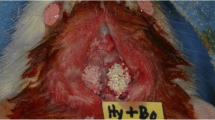Abstract
Autologous free fat grafts have been successfully used to limit ingrowth of postlaminectomy fibrous tissue and to prevent reossification after bone resection in long bones. This study was designed to test the effect of placing autologous adipose tissue in standardized craniotomy defects and also to determine the effect of the presence of periosteum and dura in the area of the fat augmented defects. In 18 immature rabbits, aged 18–21 days, two identical full-thickness defects were made bilaterally in the parietal bone. An autologous free fat graft was placed in one of the defects, the second being an internal control. The study groups were as follows: Group I: dura and periosteum left intact; Group II; periosteum removed; dura left intact; Group III; periosteum and dura removed. The animals were sacrificed after ten weeks. Histological examination of all groups demonstrated prevention of bone regeneration at the margins of the defect with some variations. In the first and second groups, new bone formation appeared over the dura, creating an incomplete plate of bone. On the periosteal side of the graft, a smaller amount of bone formation appeared close to the osteotomy line. The third group demonstrated a total prevention of bone regeneration. The use of free fat tissue graft can prevent calvarial bone regeneration and may be a useful adjunct for the treatment of craniosynostosis. Measures should be taken regarding the new bone formation over the dura, since this may cause reoccurrence of craniosynostosis.
Similar content being viewed by others
References
Anderson FM, Johnson FL (1956) Craniosynostosis — a modification in surgical treatment. Surgery 40:961–970
Billings E, May JW (1989) Historical review and present status of free fat graft autotransplantation in plastic and reconstructive surgery. Plast Reconstr Surg 83:368–381
Boyd E (1962) Organ weights from birth to maturity. Man, North American. In: Altman PL, Dittner DS (eds) Growth including reproduction and morphological development. Federation of American Societies for Experimental Biology, Washington, p 346
Brandt L, Alberius P, Ljuggren B (1986) The use of Zenker's solution in linear craniectomy for craniosynostosis: The technical modification and reappraisal. Acta Neurochir (Wien) 83:67–70
Bryant MS, Bremer AM, Nguyen TQ (1983) Autogenic fat transplants in the epidural space in routine lumbar spine surgery. Neurosurgery 13:367–370
Burton CV (1984) Full thickness autogenous fat grafts in the prevention of epidural fibrosis. Contemp Neurosurg 5:1–5
DavidDJ, Poswillo D, Simpson D (1982) The craniosynostosis: causes, natural history and management. Springer, Berlin Heidelberg New York
Fatah MF, Ermis I, Poole MD, Shun-Shin GA (1992) Prevention of cranial reossification after surgical craniectomy. J Craniofacial Surg 13:170–172
Gorlin RJ, Cohen MM, Levin LS (1990) Syndromes of the hand and neck, 3rd edn. Oxford University Press, p 922
Ingraham FD, Matson DD, Alexander Jr (1948) Experimental observation in the treatment of craniosynostosis. Surgery 23:262–268
Kiviluoto O (1976) Use of free fat transplants to prevent epidural scar formation. An experimental study. Acta Orthop Scand [Suppl] 164:3–75
Masoud I, Shapiro F, Moses A (1986) Longitudinal roentgencephalometric study of the growth of New Zealand white rabbits: cumulative and biweekly incremental growth rates for skull and mandible. J Craniofac Genet Dev Biol 6:259–387
Mayfield HF (1980) Autologous fat transplant for the protection and repair of the spinal dura. Clin Neurosurg 27:349–361
Merikanto JE, Alhopuro S, Ritsila VA (1987) Free fat transplants prevents osseous reunion of skull defects. A new approach in the treatment of craniosynostosis. Scand J Plast Reconstr Surg 21:183–188
Muakkassa KF, Hoffman HJ, Hinton DR, Hendrick EB, Humphreys RP, Ash J (1984) Lambdoid synostosis. Part 2: Review of cases managed at The Hospital for Sick Children 1972–1982. J Neurosurg 61:340–347
Paul RP, Sugar O (1972) Zenker's solution in the surgical treatment of craniosynostosis. J Neurosurg 36:604–607
Peer LA (1956) The neglected “free fat graft”, its behavior and clinical use. Am J Surg 92:40–47
Reid CA, McCarthy JG, Kolber AB (1981) A study of regeneration in parietal bone defect in rabbits. Plast Reconstr Surg 67:591–596
Saunders MC, Keller JT, Dunsker SB, Mayfield FH (1981) Survival of autologous fat grafts in humans and in mice. Connective Tissue Res 8:85
Shillito J Jr, Matson DD (1968) Craniosynostosis — a review of 519 surgical patients. Pediatrics 41:829–853
Stein SC, Schut L (1977) Management of scaphocephaly. Surg Neurol:153–155
Van der Werf AJM (1977) Craniosynostosis — a new operative technique. Clin Neurol Neurosurg 80:70–81
Vollmer DG, Jane JA, Park TS, Persing JA (1984) Variants of sagittal synostosis. Strategies for surgical correction. J Neurosurg 61:557–562
Weisz GM, Gal A (1986) Long term survival of a free fat graft in spinal canal. A 40 month postlaminectomy case report. Clin Orthop Relat Res 205:204–206
Author information
Authors and Affiliations
Rights and permissions
About this article
Cite this article
Rachmiel, A., Sugihara, T., Jackson, I.T. et al. The use of autologous free fat tissue in prevention of calvarial bone regeneration: an experimental study. Eur J Plast Surg 18, 27–31 (1995). https://doi.org/10.1007/BF00183695
Issue Date:
DOI: https://doi.org/10.1007/BF00183695




